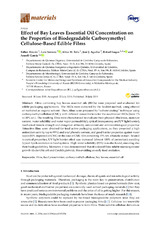Effect of Bay Leaves Essential Oil Concentration on the Properties of Biodegradable Carboxymethyl Cellulose-Based Edible Films
Autor
Rincón, E.
Serrano, Luis
Balu, Alina M.
Aguilar, José J.
Luque, Rafael
García, Araceli
Editor
MDPIFecha
2019Materia
FilmsFood preservation
Carboxymethyl cellulose
Bay leaves
Essential oil
METS:
Mostrar el registro METSPREMIS:
Mostrar el registro PREMISMetadatos
Mostrar el registro completo del ítemResumen
Films containing bay leaves essential oils (BEOs) were prepared and evaluated for edible packaging applications. The BEOs were extracted by the Soxhlet method, using ethanol or methanol as organic solvent. Then, films were prepared by “solvent casting” technique using carboxymethyl cellulose (CMC), with different concentrations for the as-obtained BEOs (from 1% to 30% wt.). The resulting films were characterized to evaluate their physical (thickness, moisture content, water solubility and water vapor permeability), optical (transparency and UV-light barrier), mechanical (tensile strength and elongation at break), antioxidant and antimicrobiological properties Attractive films were obtained for food active packaging applications, as they presented a high antioxidant activity (up to 99%) and total phenolic content, and good barrier properties against water vapor (50% improved of CMC) in the case of CMC-film containing 15% wt. ethanolic extract. Related to optical properties, UV-light barrier effect was increased (almost 100% of protection) avoiding typical lipids oxidation in food systems. High water solubility (93%) was also found, ensuring also their biodegradability. Moreover, it was demonstrated that developed films inhibit microorganisms’ growth (Escherichia coli and Candida glabrata), this avoiding an early food oxidation.

